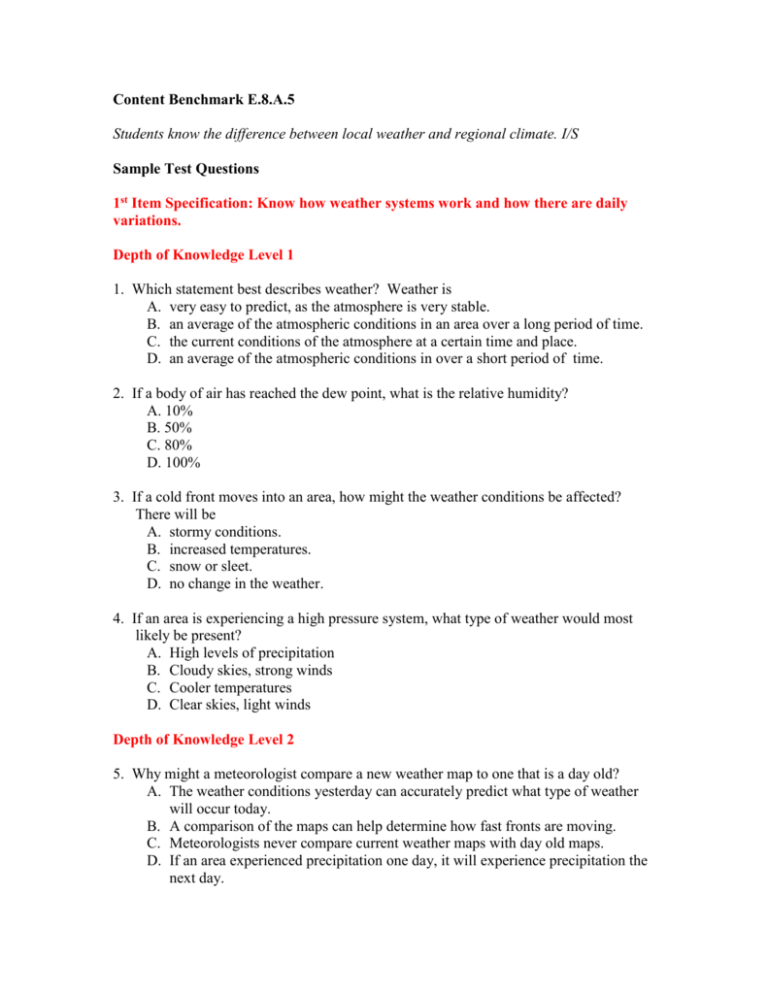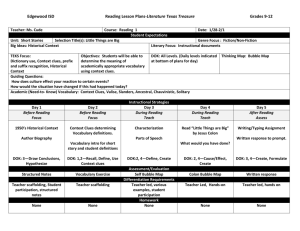printer-friendly sample test questions
advertisement

Content Benchmark E.8.A.5 Students know the difference between local weather and regional climate. I/S Sample Test Questions 1st Item Specification: Know how weather systems work and how there are daily variations. Depth of Knowledge Level 1 1. Which statement best describes weather? Weather is A. very easy to predict, as the atmosphere is very stable. B. an average of the atmospheric conditions in an area over a long period of time. C. the current conditions of the atmosphere at a certain time and place. D. an average of the atmospheric conditions in over a short period of time. 2. If a body of air has reached the dew point, what is the relative humidity? A. 10% B. 50% C. 80% D. 100% 3. If a cold front moves into an area, how might the weather conditions be affected? There will be A. stormy conditions. B. increased temperatures. C. snow or sleet. D. no change in the weather. 4. If an area is experiencing a high pressure system, what type of weather would most likely be present? A. High levels of precipitation B. Cloudy skies, strong winds C. Cooler temperatures D. Clear skies, light winds Depth of Knowledge Level 2 5. Why might a meteorologist compare a new weather map to one that is a day old? A. The weather conditions yesterday can accurately predict what type of weather will occur today. B. A comparison of the maps can help determine how fast fronts are moving. C. Meteorologists never compare current weather maps with day old maps. D. If an area experienced precipitation one day, it will experience precipitation the next day. 6. Use the weather map below showing a precipitation forecast for the Southwestern United States to answer the question that follows. (Map reference http://www.weather.com/weather/local/89123?lswe=89123&lwsa=WeatherLocalUndeclared&from=whatwhere) Which statement best describes the type of weather being experienced in the majority of the Southwestern United States? A. Sunny and clear B. Icy with fog present C. Cloudy with precipitation D. Strong storms occurring 7. Use the weather map below showing weather conditions in the United States from May 7th to answer the question that follows. In which direction is the warm front near the Great Lakes moving? A. North B. South C. East D. West 2nd Item Specification: Compare regional climates and describe how climate regions are influenced. Depth of Knowledge Level 1 8. A region’s climate is A. not affected by daily weather. B. changed only by human activity. C. an average of a region’s weather over a short period of time. D. an average of a region’s weather over a long period of time. 9. When determining a region’s climate, the two main variables considered are the average A. air temperature and the size of the region. B. precipitation and average air temperature. C. wind speed and the types of animals present. D. barometric pressure and the average precipitation. 10. Which climate zone has the highest average temperature? A. Chaparral B. Polar C. Temperate D. Tundra Depth of Knowledge Level 2 11. In what way do temperate deserts and tropical deserts differ? Temperate deserts A. have more severe summers than tropical deserts. B. do not receive as much precipitation as tropical deserts. C. experience higher temperatures than tropical deserts. D. experience lower temperatures than tropical deserts. 12. The graph below shows the average monthly temperatures in several cities. Use this graph to answer following question. Month of Year vs. Average Temperature in Degrees Celcius Vostok, near pole of inaccessibility 20 Amundsen-Scott South Pole No v Se p Ju l ay M M -20 ar 0 Ja n Average Temperature in Degrees Celcius 40 New York -40 London -60 Sydney -80 Month of Year (Derived from http://www.coolantarctica.com/Antarctica%20fact%20file/antarctica%20environment/climate_graph/antarctica_climate_graph_comparitive.htm) Based on the average temperatures, which two areas have the most similar climates? A. Sydney and New York B. McCurdo and Amundsen Scott C. Vostok and Amundsen-Scott D. London and Sydney 3rd Item Specification: Recognize and use weather instruments to determine local weather. Depth of Knowledge Level 1 13. Use the illustrations of weather tools below to answer the question. 1) 3) 2) 4) Which weather tool would be used to measure wind speed? A. Tool #1 B. Tool #2 C. Tool #3 D. Tool #4 14. Which weather tool is used to measure air pressure? A. Barometer B. Anemometer C. Thermometer D. Psychrometer Depth of Knowledge Level 2 15. Use the graph showing the relationship between temperature and relative humidity to answer the question that follows. Temperature in Degrees Celsius vs. Amount of Water Vapor in Grams per Cubic Meter (Graph reference http://www.bom.gov.au/lam/humiditycalc.shtml) As air temperature increases the amount of water vapor that can be held A. decreases. B. increases. C. stays the same. D. increases and then decreases. 16. Which weather tool is used to measure the average energy of the particles present? A. Barometer B. Anemometer C. Thermometer D. Psychrometer 4th Item Specification: Understand the result of human impact on local weather and climate (e.g., heat island of cities, deforestation, thermal inversion, and fires). Depth of Knowledge Level 1 17. Which of the following is NOT a way humans directly impact weather and climate? A. Deforestation B. Fencing grasslands C. Burning of fossil fuels D. Construction of new buildings 18. Deforestation and construction increases the heat island effect by all of the following EXCEPT A. There are fewer areas for agriculture, resulting in less food for people to eat. B. Reducing the amount of evaporation and the cooling effects of shading. C. The construction of buildings increase radiated energy and reduces air flow. D. Waste heat created by humans in the form of vehicle, industrial and residential use increases temperatures. 19. Use the graph showing an Urban Heat Island Profile to answer the question that follows. (Profile reference http://www.epa.gov/hiri/about/index.html) Where are temperatures the highest? A. Suburban areas B. Rural areas C. Downtown areas D. Commercial areas Depth of Knowledge Level 2 20. Trees and vegetation are removed from a rural area in order to construct a large shopping mall. What will happen to the average temperatures in the shopping mall area? Average temperatures will A. increase. B. decrease. C. not change. D. fluctuate randomly. 21. Use the graph showing an Urban Heat Island Profile to answer the question that follows. (Profile reference http://www.epa.gov/hiri/about/index.html) What affect does decreasing vegetation have on temperatures? With decreasing vegetation, temperatures will A. decrease. B. increase. C. stay the same. D. increase and then decrease. Constructed Response E.8.A.5 1. The map below shows locations of different climates in the world. (From http://www.mapsofworld.com/world-maps/world-climate-map.html) A. Describe the similarities between latitude and climate? Provide examples to support your answer. B. Compare the climate of North Africa to that of The Northern United States of America. Give reasons for the differences in climate. Content Benchmark E.8.A.5 Students know the difference between local weather and regional climate. I/S Answers to Sample Test Questions 1. C, DOK Level 1 2. D, DOK Level 1 3. A, DOK Level 1 4. D, DOK Level 1 5. B, DOK Level 2 6. C, DOK Level 2 7. A, DOK Level 2 8. D, DOK Level 1 9. B, DOK Level 1 10. A, DOK Level 1 11. D, DOK Level 2 12. C, DOK Level 2 13. B, DOK Level 1 14. A, DOK Level 1 15. B, DOK Level 2 16. C, DOK Level 2 17. B, DOK Level 1 18. A, DOK Level 1 19. C, DOK Level 1 20. A, DOK Level 2 21. B, DOK Level 2 Constructed Response E.8.A.5 Score Rubric Response addresses all parts of the question clearly and correctly. 3 points A. Noting that similar latitudes have similar climates. For example, Northern Canada, and Northern Asia, located on or near 60 degrees N latitude both having snow, fully humid and cool summers, or the parts of South America, Africa and Australia along 10 degrees S latitude all being Aw – or equatorial deserts. B. B. When comparing North Africa, and Northern USA there should be a mention of the differences in latitude, 40 degrees N, above the Tropic of Cancer, versus 30 degrees N below the Tropic of Cancer. The closer to the equator, the higher the temperatures will be due to the increased amount of radiation. The farther north the location, the less direct radiation received, therefore lower temperatures. Because of this, N. Africa which is closer to the equator will have much higher temperatures than N. USA. Also N. Africa has an arid climate, which means there is little precipitation. N. USA has a more humid climate which means there is more precipitation. 2 points Response addresses all parts of the question and includes only minor errors. 1 point Response does not address all parts of the question. 0 points The response is totally incorrect or no response provided.









